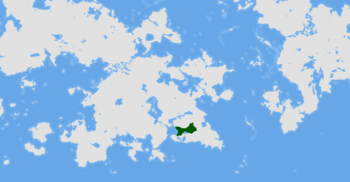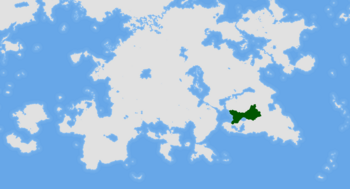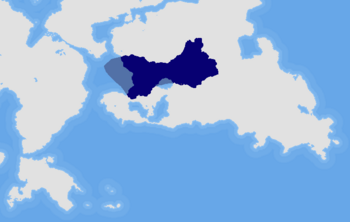Federation of Yugoslavia: Difference between revisions
Yugoslavia (talk | contribs) No edit summary |
Yugoslavia (talk | contribs) No edit summary |
||
| Line 103: | Line 103: | ||
About 1,000 BCE, unknown people arrive to the shores of Kolpa Lake, which are called [[Proto-Slavs of Yugoslavia|Proto-Slavonic]]. Not much is known about them, but it is presumed they had to be skilled warriors to penetrate through other surrounding tribes and inhabit the mentioned territories. Several tribes, such as ''[[Bardini tribe|Bardini]]'', ''[[Gorki tribe|Gorki]]'', and ''[[Erjenci]]'', are counted as Proto-Slavonic, and they inhabited these lands until the arrival of the Slavs some six centuries later. | About 1,000 BCE, unknown people arrive to the shores of Kolpa Lake, which are called [[Proto-Slavs of Yugoslavia|Proto-Slavonic]]. Not much is known about them, but it is presumed they had to be skilled warriors to penetrate through other surrounding tribes and inhabit the mentioned territories. Several tribes, such as ''[[Bardini tribe|Bardini]]'', ''[[Gorki tribe|Gorki]]'', and ''[[Erjenci]]'', are counted as Proto-Slavonic, and they inhabited these lands until the arrival of the Slavs some six centuries later. | ||
=== Antiquity (7th century BCE–6th century CE) === | |||
Tribal societies of Proto-Slavonic people... | |||
Revision as of 20:17, 21 December 2023
Royal State of the Federation of Yugoslavia Koroljevska Deržava Federacije Jugoslavije (Chernogorkan)
Королйевска Держава Федерацийе Йугославийе (Cyrillic) | |
|---|---|
| Motto: Jeden narod, jeden korolj, jedna deržava "One people, one king, one state" | |
| Anthem: "Hej Slaveni!" "Hey Slavs!" | |
Location of Yugoslavia (blue or dark green) | |
| Capital and largest city | Chernograd |
| Official languages | Chernogorkan |
| Recognised national languages | Chernogorkan, Cordomonivence Slavonic |
| Ethnic groups (2019) | Chernozemci (43%) Gorkanki (31%) Storonci (11%) Morrawian (9%) Other (6%) |
| Demonym(s) | Yugoslav |
| Government | Parliamentary democracy under a constitutional monarchy |
• King of Yugoslavia | Paul I |
• Prime Minister | Nikolaj Novosel |
| Legislature | The Federal Assembly of Yugoslavia |
| The Royal Council | |
| The House of Peoples | |
| Establishment | |
• Arrival of the Slavs | 6th century |
• Duchy of Gorka | 10th century |
• Great Peasant Rising | 1493 |
• Kingdom of Gorka | 1711 |
• Liberation of Chernozemye | 27th August 1815 |
• Unification referendum | 18th November 1953 |
• Federation of Yugoslavia | 14th January 1955 |
• Coronation of Paul I | 1st December 1992 |
| Area | |
• Total | 486,255.971 km2 (187,744.480 sq mi) |
| Population | |
• 2022 estimate | 84,833,022 |
• August 2019 census | 83,772,916 |
• Density | 172.28/km2 (446.2/sq mi) |
| GDP (PPP) | 2022 estimate |
• Total | $3,828 trillion |
• Per capita | $45 695 |
| GDP (nominal) | 2022 estimate |
• Total | $2,711 trillion |
• Per capita | $32 381 |
| Gini (2019) | low |
| HDI (2018) | very high |
| Currency | Yugoslav dinar (đ) 1đ:1.17€ |
| Time zone | UTC 0 |
| Date format | dd. mm. yyyy. |
| Driving side | right |
| Calling code | +38 |
| ISO 3166 code | YU |
| Internet TLD | .yu |
The Federation of Yugoslavia, officially the Royal State of the Federation of Yugoslavia (Chernogorkan: Koroljevska Deržava Federacije Jugoslavije, Королйевска Держава Федерацийе Йугославийе; known informally as Yugoslavia) is a country located in the Southeastern Thrismari. It is surrounded by Lindstaten to the north, Wassilia to the east, Sacrofnia and the Kolpa Lake to the south, and the Kaldaz Ocean shoreline to the west. It's three federated units, krajine/крайине, and the capital district comprise a total area of 486,255.971 km2 (187,744.48 square miles), on which reside 83,772,916 residents (2019 Census), corresponding to 172.28 per km2 (446.21 per sq mi). Yugoslavia is a parliamentary democracy under a constitutional monarchy, ruled by king Paul I of the House of Karažev since 1992. The federal capital is Chernograd (Chernogorkan: Černograd, Черноград; lit. black city), a city of more than 8 million people situated on the shores of Kolpa Lake; the city is the financial, industrial, and scientific centre of Yugoslavia, hosting the Royal Institute of Science and the University of Chernograd. The entire nation is mostly flat in the interior; the littoral region is moderately hilly and uneven, while the eastern borderlands with Wassilia are composed of mostly low summits and peaks of the Trizub mountain range. The highest summit is in the northeasternmost corner of the country, Sventovid Peak, measuring at 2,063 metres above sea level.
The first traces of human activity in the lands of contemporary Yugoslavia are about 1.1 million years old. About 350,000 years ago, there are traces of Neanderthal presence in Yugoslavia, located in Velika Plana cave of the Trizub mountain range. Cro-magnons appeared some 40,000 years ago, but have left no significant traces of their presence, possibly because the Homo sapiens arrived approximately 10,000 years later and became the dominant variant of modern humans. Neolithic era brought about Halka culture around the Kolpa Lake, and Janski culture in the littoral region, and both left several localities abundant with artefacts, which showed that these dwellers were technologically more developed than similar cultures, which is proved by evidence of their engaging in agriculture and livestock raising. These cultures were lost to us around 5 000 BCE, and traces of human activity reappear in 1000 BCE, with the arrival of Proto-Slavonic peoples to the shores of Kolpa Lake. It is not known who were these people, nor how they arrived, but by the time Slavs arrived in the 6th century CE they had largely disappeared. Slavs subdued the local population and lived in tribal societies, until the rise of the Duchy of Gorka in the 10th century (probably in 926) by the duke Nikolaj Mogelov. The Duchy lasted until 1231, when it crumbled under the Christianisation armies led by Methodius the Bright, who split the duchy into multiple bishoprics tasked with converting Slavs to Christianity.
Modern Yugoslavia was created after the Unification Referendum of 1953, which was the result of many economic and political crises in the Republic of Chernozemye and the Kingdom of Gorka. The referendum received widespread support in both countries, and the results precipitated the unification of Chernozemye and Gorka on 14th January 1955 into the Federation of Yugoslavia under the House of Karažev, which ruled Gorka since 1711. The current King of Yugoslavia is Paul I, who ascended the throne following his father's death in February of 1992; his coronation took place on 1st September 1992.
Today, Yugoslavia is a regional pillar of scientific research and cultural heritage. The Royal Institute of Science, a prestigious facility in Chernograd running since 1972, is entirely funded by the royal family, and is the most prestigious education hub for STEM fields in the country, and beyond. Since 1990s, the standard of living in Yugoslavia increased dramatically, and today hosts productive populace and a resilient and diversified economy. It remains one of the most influential and developed Slavic nations in Anteria.
Etymology
The name Yugoslavia, an anglicised transcription of Jugoslavija, is a compound word made up of jug ('yug'; with the 'j' pronounced like an English 'y') and slavija. The Slavic word jug means 'south', while slavija ("Slavia") denotes a 'land of the Slavs'. Thus, a translation of Jugoslavija would be 'South-Slavia' or 'Land of the South Slavs'. It was used informally for the lands of Chernozemye and Gorka since the beginning of the 19th century, popularised after the Slavic Renaissance movement. By the end, the people of Chernozemye and Gorka widely embraced the name, giving it roots in national conscience.
History
Prehistory
Earliest evidence of human settlement around the Kolpa Lake dates back more than a million years back. Sediments around the lake built protective layers of earth which managed to preserve numerous specimens of fossilised bone from the Paleolithic era, as well as some tools and weapons. As the Paleolithic era progressed, the bones changed, which suggests the arrival and dominance of Homo Neanderthalensis (Neanderthal), which have left most of their traces in the Trizub mountains; in 1911, Velika Plana cave was discovered, and in it numerous artefacts, bones, tools, and pottery. It is by far the largest locality in Yugoslavia concerning the history of human settlement, as more than two hundred artefacts and seven fully preserved skeletons were found there. Most of the discoveries from Velika Plana cave are located in the Yugoslav Archaeological Museum in Krasna Gorka.
Around 40,000 years ago, the Homo Sapiens superseded the Neanderthals, who slowly vanished, as last confirmed Neanderthal remains date back from about 42,000 to 35,000 years ago. The arrival of modern humans brought about improvements in tool and arms quality; as the Mesolithic began, focus diverted from hunting to gathering. It is now that first sedentary people might have stopped moving around, but stuck to an area for a prolonged period of time, as proved by several quasi-settlements discovered near Chernograd, by Kolpa Lake. Around 8,000 years ago, the Neolithic began, which saw the emergence of Janski and Halka cultures. Dwellers of the Janski culture lived in moderatly hilly area of the Gorka Littoral, a region prone to droughts and instability, and the indicative of this is their mastery over weapons and metalware, and relative backwardness concerning agriculture. On the other hand, Halka culture seemed to be specialised toward agricultural activities; they are considered the pioneers of agriculture in the greater area. Helped by moderate climate and the vicinity of Kolpa Lake, this allowed the Halka culture to begin trading excess food with the neighbouring tribes, which marked the beginning of commercial activity in Yugoslavia. The cultures left many artefacts and evidence of their progress, such as Daždec and Běli Sašek localities, proving that they handled livestock and farming. Inexplicably these cultures fell some 5,000 years BCE, which left several thousand years without any major evidence of human activity.
About 1,000 BCE, unknown people arrive to the shores of Kolpa Lake, which are called Proto-Slavonic. Not much is known about them, but it is presumed they had to be skilled warriors to penetrate through other surrounding tribes and inhabit the mentioned territories. Several tribes, such as Bardini, Gorki, and Erjenci, are counted as Proto-Slavonic, and they inhabited these lands until the arrival of the Slavs some six centuries later.
Antiquity (7th century BCE–6th century CE)
Tribal societies of Proto-Slavonic people...


